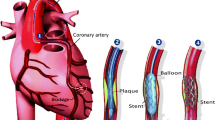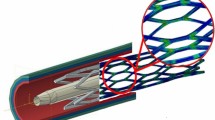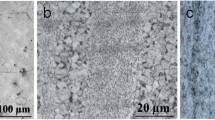Abstract
The implementation of biodegradable stents has the potential to revolutionize obstructive coronary artery disease treatment. Limitations still currently exist, however, that prevent biodegradable stents from replacing permanent metallic stents in the global market. The ideal combination of stent properties, including sufficient mechanical strength, controlled degradation, and biocompatibility, has yet to be realized. A novel manufacturing process is proposed that utilizes cold gas-dynamic spraying to fabricate a metal structure with significantly reduced grain size. Iron and stainless steel 316L are combined to form a novel amalgamate with enhanced mechanical strength and a controllable degradation rate, due to the resulting microgalvanic reaction. Flat specimens composed of iron and 316L are fabricated in various compositions, and mechanical and degradation tests were conducted. Femto laser techniques are utilized to produce stents composed of 80% Fe and 20% stainless steel 316L. The in vitro degradation behaviour of the stent is investigated using static and dynamic corrosion tests. It is shown that the corrosion rate can be adjusted to desired values, by varying the weight percentage of iron and stainless steel 316L within the amalgamate.









Similar content being viewed by others
References
Al-Mangour, B. The use of cold sprayed alloys for metallic stents. Master’s of Engineering, Department of Mechanical Engineering, McGill University, Montreal, Canada, 2012.
Al-Mangour, B., R. Mongrain, E. Irissou, and S. Yue. Improving the strength and corrosion resistance of 316L stainless steel for biomedical applications using cold spray. Surf. Coat. Technol. 216:297–307, 2013.
ASTM G31-12a. Standard Guide for Laboratory Immersion Corrosion Testing of Metals. West Conshohocken, PA: ASTM International, 2012. doi:10.1520/G0031-12A
ASTM G71-81. Standard Guide for Conducting and Evaluating Galvanic Corrosion Tests in Electrolytes. West Conshohocken, PA: ASTM International, 2014. doi:10.1520/G0071
Barua, R. Study of the structural properties and control of degradation rate for biodegradable metallic stents using cold spray. Doctor of Philosophy, Department of Mechanical Engineering, McGill University, Montreal, Quebec, 2015.
Bertrand, O. F., R. Sipehia, R. Mongrain, J. Rodés, J. C. Tardif, L. Bilodeau, G. Côté, and M. G. Bourassa. Biocompatibility aspects of new stent technology. J. Am. Coll. Cardiol. 32(3):562–571, 1998.
Champagne, V. K. The Cold Spray Materials Deposition Process: Fundamentals and Applications. Cambridge: Woodhead Publishing, 2007.
Drynda, A., T. Hassel, F. W. Bach, and M. Peuster. In vitro and in vivo corrosion properties of new iron–manganese alloys designed for cardiovascular applications. J. Biomed. Mater. Res. B Appl. Biomater. 103(3):649–660, 2015.
Francis, A., Y. Yang, S. Virtanen, and A. R. Boccaccini. Iron and iron-based alloys for temporary cardiovascular applications. J. Mater. Sci. Mater. Med. 26(3):1–16, 2015.
Geers, M. G. D., W. A. M. Brekelmans, and P. J. M. Janssen. Size effects in miniaturized polycrystalline FCC samples: strengthening versus weakening. Int. J. Sol. Struct. 43(24):7304–7321, 2006.
Henning, M., and V. Horst. Statistical size effects based on grain size and texture in thin sheets. Mater. Sci. Eng. A. 452(1):602, 2007.
Hermawan, H. Biodegradable Metals: From Concept to Applications. Berlin: Springer, pp. 49–57, 2012.
Hermawan, H., D. Dube, and D. Mantovani. Degradable metallic biomaterials: design and development of Fe-Mn alloys for stents. J. Biomed. Mater. Res. A. 93(1):1–11, 2010.
Hermawan, H., D. Dubé, and D. Mantovani. Degradable metallic biomaterials for cardiovascular applications. In: Metals for Biomedical Devices, edited by M. Niinomi. Cambridge: Woodhead Publishing, 2010, pp. 379–404.
Heublein, B., R. Rohde, V. Kaese, M. Niemeyer, W. Hartung, and A. Haverich. Biocorrosion of magnesium alloys: a new principle in cardiovascular implant technology? Heart 89(6):651–656, 2003.
Huang, T., J. Cheng, D. Bian, and Y. Zheng. Fe–Au and Fe–Ag composites as candidates for biodegradable stent materials. J. Biomed. Mater. Res. B Appl. Biomater. 2015. doi:10.1002/jbm.b.33389.
Jukema, J. W., T. A. N. Ahmed, J. J. W. Verschuren, and P. H. A. Quax. Restenosis after PCI. Part 2: prevention and therapy. Nat. Rev. Cardiol. 9(2):79–90, 2012.
Kalb, H., A. Rzany, and B. Hensel. Impact of microgalvanic corrosion on the degradation morphology of WE43 and pure magnesium under exposure to simulated body fluid. Corros. Sci. 57:122–130, 2012.
Kastrati, A., J. Mehilli, J. Dirschinger, F. Dotzer, H. Schühlen, F. J. Neumann, M. Fleckenstein, C. Pfafferott, M. Seyfarth, and A. Schömig. Intracoronary stenting and angiographic results: strut thickness effect on restenosis outcome (ISAR-STEREO) trial. Circulation 103(23):2816–2821, 2001.
Kirkland, N. T., N. Birbilis, and M. P. Staiger. Assessing the corrosion of biodegradable magnesium implants: a critical review of current methodologies and their limitations. Acta Biomater. 8(3):925–936, 2012.
Lucas, G. E., G. R. Odette, and J. W. Sheckherd. Shear punch and microhardness tests for strength and ductility measurements. In: Use of Small-Scale Specimens for Testing Irradiated Material, edited by W. R. Corwin, and G. Lucas. Philadelphia, PA: American Society for Testing and Materials (ASTM), 1986, pp. 112–140.
Miyazaki, S., K. Shibata, and H. Fujita. Effect of specimen thickness on mechanical properties of polycrystalline aggregates with various grain sizes. Acta Metall. 27(5):855–862, 1979.
Mongrain, R., E. Aboumansour, S. Plante, O. F. Bertrand, and J. C. Tardif. Development of a 3D CAD model for the structural analysis of a coronary stent. In: International Symposium on Advanced Materials for Biomedical Applications (SAMBA), edited by D. Mantovani. Montreal: The Canadian Institute of Mining, Metallurgy and Petroleum, 2002.
Mongrain, R., O. F. Bertrand, and S. Yue. Bioresorbable Medical Devices and Method of Manufacturing the Same. USPTO, WO 2013163747 A1, 2013.
Moore, J., J. Soares, and K. Rajagopal. Biodegradable stents: biomechanical modeling challenges and opportunities. Cardiovasc. Eng. Technol. 1(1):52–65, 2010.
Moravej, M., and D. Mantovani. Biodegradable metals for cardiovascular stent application: interests and new opportunities. Int. J. Mol. Sci. 12(7):4250–4270, 2011.
Moravej, M., A. Purnama, M. Fiset, J. Couet, and D. Mantovani. Electroformed pure iron as a new biomaterial for degradable stents: in vitro degradation and preliminary cell viability studies. Acta Biomater. 6(5):1843–1851, 2010.
Murphy, B. P., P. Savage, P. E. McHugh, and D. F. Quinn. The stress-strain behavior of coronary stent struts is size dependent. Ann. Biomed. Eng. 31(6):686–691, 2003.
Schomig, A., A. Kastrati, H. Mudra, R. Blasini, H. Schuhlen, V. Klauss, G. Richardt, and F. J. Neumann. Four-year experience with Palmaz-Schatz stenting in coronary angioplasty complicated by dissection with threatened or present vessel closure. Circulation 90(6):2716–2724, 1994.
Serruys, P. W., M. J. Kutryk, and A. T. Ong. Coronary-artery stents. N. Engl. J. Med. 354(5):483–495, 2006.
Simsekyilmaz, S., E. A. Liehn, C. Militaru, and F. Vogt. Progress in interventional cardiology: challenges for the future. Thromb. Haemost. 113(3):464–472, 2015.
Baboian, R. Corrosion Tests and Standards: Application and Interpretation (2nd ed.). West Conshohocken, PA: ASTM International, 2005. ISBN 978-0-8031-4555-9.
Zhen, Z., T.-F. Xi, and Y.-F. Zheng. A review on in vitro corrosion performance test of biodegradable metallic materials. Trans. Nonferr. Met. Soc. China. 23(8):2283–2293, 2013.
Acknowledgments
This research was funded by the Natural Sciences and Engineering Research Council of Canada (NSERC), and the McGill Engineering Doctoral Award (MEDA). The authors wish to thank Dr. Phuong Vo and Frédéric Belval at NRC-CNRC Boucherville for their assistance during the cold spray process, Ranjan Roy and Andrew Golsztajn for their assistance with data acquisition and analysis, as well as process treatments, and Ken Nsiempba.
Author information
Authors and Affiliations
Corresponding author
Additional information
Associate Editor Abdul I. Barakat oversaw the review of this article.
Jennifer Frattolin and Rajib Barua are co-first authors with equal contribution.
Rights and permissions
About this article
Cite this article
Frattolin, J., Barua, R., Aydin, H. et al. Development of a Novel Biodegradable Metallic Stent Based on Microgalvanic Effect. Ann Biomed Eng 44, 404–418 (2016). https://doi.org/10.1007/s10439-015-1458-5
Received:
Accepted:
Published:
Issue Date:
DOI: https://doi.org/10.1007/s10439-015-1458-5




